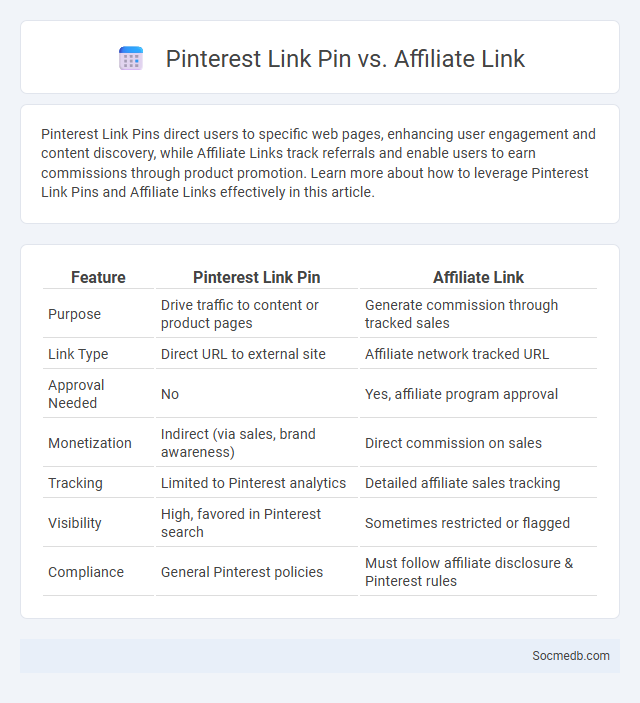
Photo illustration: Pinterest Link Pin vs Affiliate Link
Pinterest Link Pins direct users to specific web pages, enhancing user engagement and content discovery, while Affiliate Links track referrals and enable users to earn commissions through product promotion. Learn more about how to leverage Pinterest Link Pins and Affiliate Links effectively in this article.
Table of Comparison
| Feature | Pinterest Link Pin | Affiliate Link |
|---|---|---|
| Purpose | Drive traffic to content or product pages | Generate commission through tracked sales |
| Link Type | Direct URL to external site | Affiliate network tracked URL |
| Approval Needed | No | Yes, affiliate program approval |
| Monetization | Indirect (via sales, brand awareness) | Direct commission on sales |
| Tracking | Limited to Pinterest analytics | Detailed affiliate sales tracking |
| Visibility | High, favored in Pinterest search | Sometimes restricted or flagged |
| Compliance | General Pinterest policies | Must follow affiliate disclosure & Pinterest rules |
Understanding Pinterest Link Pins
Pinterest Link Pins simplify content discovery by embedding URLs directly into pins, enabling seamless navigation from images to their source websites. These pins enhance your user engagement by providing rich metadata, improving search visibility and driving traffic. Optimizing your Pinterest Link Pins with relevant keywords and high-quality images maximizes click-through rates and boosts your online presence.
What Are Affiliate Links on Pinterest?
Affiliate links on Pinterest are special URLs that contain a unique tracking code, allowing you to earn commissions when users purchase products through your pins. These links connect your followers directly to merchant sites, making it easier to monetize your Pinterest content by promoting relevant products within your niche. You can maximize your earnings by strategically incorporating affiliate links in your pin descriptions and boards.
Comparing Link Pins and Affiliate Links
Link Pins offer a visually engaging way to direct followers to specific content, enhancing click-through rates by integrating appealing images directly into social media posts. Affiliate Links, on the other hand, embed trackable URLs within content, allowing marketers to earn commissions from sales or actions generated through their promotions. While Link Pins prioritize aesthetic appeal and user engagement, Affiliate Links emphasize monetization and performance tracking, making the choice dependent on campaign goals.
How Pinterest Link Pins Work
Pinterest Link Pins work by allowing you to connect images directly to external websites, driving traffic and increasing engagement on your content. Each Link Pin includes metadata such as title, description, and site name, improving searchability and user experience. By leveraging Link Pins, your content becomes more discoverable and actionable, helping you reach a wider audience effectively.
Monetizing with Affiliate Links on Pinterest
Monetizing with affiliate links on Pinterest allows you to generate passive income by sharing curated content that resonates with your niche audience. By strategically incorporating affiliate links into visually appealing pins and optimizing descriptions with relevant keywords, you can drive targeted traffic and increase conversion rates. Your ability to consistently create engaging pins paired with analytics insights directly boosts your earning potential on this platform.
Key Differences: Pinterest Link Pins vs Affiliate Links
Pinterest Link Pins direct users to specific webpages such as product pages or blog posts, enhancing user engagement through visual discovery. Affiliate Links on Pinterest incorporate tracking codes that attribute sales or clicks to the promoter, enabling monetization through commissions. While Link Pins are primarily designed for seamless navigation, Affiliate Links focus on revenue generation by leveraging influencer marketing and targeted content sharing.
Pros and Cons of Each Link Type
Internal links in social media enhance user navigation and increase page views by directing users to relevant content within the same platform, but excessive internal linking can overwhelm users and reduce engagement. External links drive traffic to authoritative sources, improving credibility and SEO, yet they risk users leaving the platform and decreasing time spent on site. Affiliate links generate revenue through commissions, benefiting content creators, but may lead to user distrust if overused or perceived as spammy.
Best Practices for Using Pinterest Link Pins
Pinterest Link Pins drive high-quality traffic by directly connecting users to relevant external webpages, enhancing content discoverability and engagement. Employ compelling, keyword-rich descriptions and high-resolution images to improve pin visibility and click-through rates. Consistent use of targeted hashtags and strategic board placement further optimizes link performance and increases follower interaction.
Compliance and Disclosure: Affiliate Link Guidelines
Social media platforms require strict adherence to compliance and disclosure regulations when promoting products through affiliate links to maintain transparency and trust with the audience. Your affiliate links must be clearly labeled to comply with guidelines set forth by the Federal Trade Commission (FTC) and other regulatory bodies, ensuring users are aware of the relationship between you and the affiliate brand. Failure to disclose properly can result in penalties and damage to your credibility across platforms like Instagram, YouTube, and TikTok.
Which Link Strategy is Right for Your Pinterest Marketing?
Choosing the right link strategy for Pinterest marketing depends on your goals, whether driving traffic to a blog, e-commerce site, or brand landing page. Utilizing direct links to product pages enhances conversion rates by delivering users to purchase points, while linking to blog posts or tutorials builds engagement and brand authority. Incorporate UTM parameters to track traffic sources and optimize future Pinterest campaigns based on detailed analytics insights.
 socmedb.com
socmedb.com